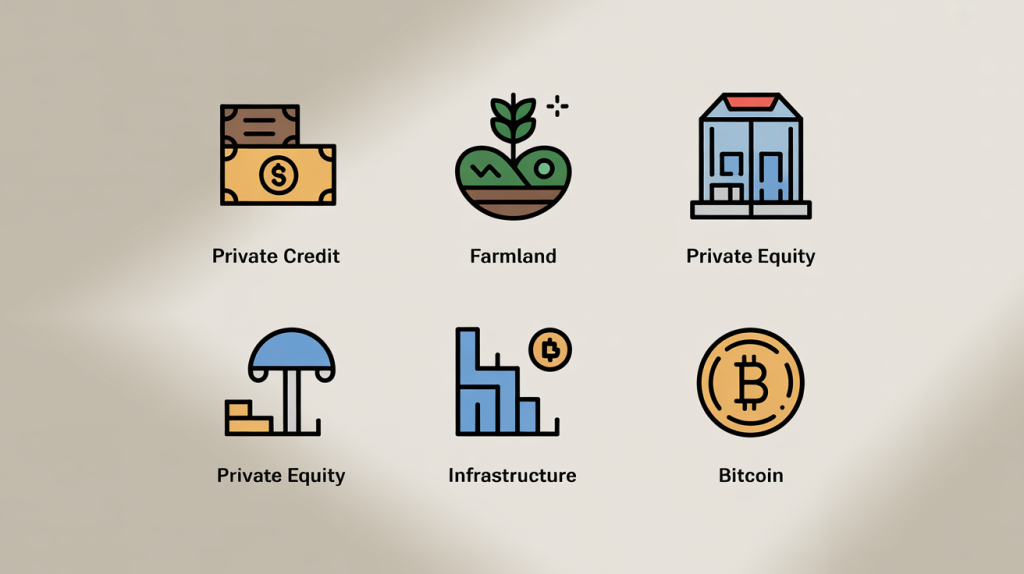
Investors Are Quietly Stepping Off the Beaten Path
You’re not imagining it. Traditional 60/40 portfolios are underperforming, and the S&P 500 is increasingly top-heavy with a handful of mega-cap stocks masking broader market fragility. As inflation proves sticky, interest rates remain elevated, and geopolitical tensions disrupt global trade, the case for alternative asset classes has never been stronger. The institutions moved first. Now, you can follow with a clear strategy and the right asset mix.
1. Private Credit: Lending Like a Bank, Earning Like a Hedge Fund
The search for yield has returned, but it’s not in bonds. In a high-rate world where banks are tightening lending, private credit is stepping in to fill the void. Middle-market businesses still need capital, and traditional financing isn’t always an option. That mismatch is your opportunity.
Private credit lets you capture equity-like returns through debt. Think senior secured loans, floating rates, and strong covenants. With yields often in the 9–13% range, and borrowers backed by collateral, you’re taking on risk, but it’s intelligently priced. As long as inflation and rates stay elevated, this yield premium is likely to persist. The market for private credit could double by 2030, and you don’t need to be a fund manager to participate anymore.
How to invest:
- Main Street Capital (MAIN), Oaktree Specialty Lending (OCSL), and Golub Capital BDC (GBDC) are business development companies (BDCs) offering direct exposure.
- Blackstone Private Credit Fund (BCRED) is available to accredited investors.
- iShares Broad USD High Yield Corporate Bond ETF (USHY) offers exposure to high-yield credit, though less targeted than direct private credit.
We maintain an allocation to MAIN in the Founder’s Club Rapid Wealth Compounder Portfolio due to its consistent yield and high-quality underwriting discipline.
2. Farmland: Inflation Protection with Real Returns
It’s not just retail investors waking up to the value of farmland. Institutional capital is already making moves. Most notably, Bill Gates has become the largest private owner of farmland in the United States, reportedly owning over 275,000 acres as of 2022. That should tell you something about its long-term potential.
They’re not making more land, but the world keeps adding people. As climate volatility impacts crop yields and food security becomes strategic policy, farmland emerges as one of the most durable wealth preservation assets.
Farmland offers two sources of return: cash flow from leases or crop share, and land value appreciation. It’s inherently inflation-linked. When food prices rise, so does the value of the land that produces it. In a decade likely to be marked by monetary instability and geopolitical shifts, owning productive soil becomes a hedge you can rely on. Institutional capital is already chasing this, but platforms are making it accessible for individual investors too.
How to invest:
- Farmland Partners (FPI) and Gladstone Land (LAND) are two REITs that own and lease U.S. farmland.
- AcreTrader and FarmTogether are private platforms that offer fractional farmland ownership.
3. Private Equity Secondaries: Discounted Access to Alpha
The private equity secondary market is booming for one reason: sellers need liquidity, and buyers have the edge. You’re not funding early-stage ideas or locked in for a decade. You’re stepping into an existing fund at a discount, often 10–30% below net asset value.
These are seasoned, diversified funds that have already deployed capital. You get exposure to maturing companies with an exit runway, not unproven startups. Secondaries offer an elegant solution to owning better performing private markets: better pricing, shorter holding periods, and access to high-quality deals that would otherwise be off-limits.
How to invest:
- Pantheon International PLC (PIN.L) is a London-listed closed-end fund focused on secondary private equity.
- HarbourVest Global Private Equity (HVPE.L) offers diversified exposure to secondaries and co-investments.
- U.S. investors can access secondaries through private feeder funds or platforms like Moonfare or Forge Global, subject to accreditation.
4. Real Asset Infrastructure: Own What the World Cannot Function Without
Infrastructure is getting a once-in-a-century upgrade. From energy transition to digital backbone expansion, the need for private capital in critical infrastructure is growing rapidly. These assets, power grids, water systems, ports, and data centers, aren’t just essential, they’re lucrative.
They deliver stable, often inflation-indexed cash flows. They’re usually underpinned by long-term contracts or regulated returns. And they operate in sectors where demand is non-discretionary. As the global economy becomes more digital and less predictable, infrastructure investments offer both resilience and return.
How to invest:
- Brookfield Infrastructure Partners (BIP) and Cohen & Steers Infrastructure Fund (UTF) provide diversified infrastructure exposure.
- Global X U.S. Infrastructure Development ETF (PAVE) and iShares Global Infrastructure ETF (IGF) are low-cost options.
- Direct investment via funds like IFM Global Infrastructure may be available to institutions and high-net-worth individuals.
We maintain an allocation to UTF in the Founder’s Club Rapid Wealth Compounder Portfolio due to its blend of income generation and inflation-sensitive assets.
5. Bitcoin: The Digital Lifeboat in a Sea of Debasement
Whether you love it or hate it, Bitcoin is here. It has survived multiple boom-and-bust cycles and keeps coming back stronger. What makes it compelling today is not hype but context. Governments are piling on debt. Fiat currencies are under pressure. Confidence in institutions is eroding.
Bitcoin is a digital bearer asset with no counterparty risk. Its supply is capped, it trades globally, and it operates 24/7. With ETF approvals and institutional adoption underway, Bitcoin is maturing into an investable asset class. You don’t allocate to Bitcoin because it’s safe. You allocate to Bitcoin because the alternative might be worse.
How to invest:
- Grayscale Bitcoin Trust (GBTC) and newly approved spot Bitcoin ETFs (like iShares Bitcoin Trust (IBIT) and Fidelity Wise Origin Bitcoin Fund (FBTC))
- Coinbase or Fidelity Crypto for direct Bitcoin custody
- Bitcoin IRAs through platforms like BitcoinIRA or iTrustCapital for tax-advantaged exposure
We maintain an allocation to FBTC in the Founder’s Club Dynamic Core Hedge Portfolio as part of our long-term strategy to hedge against monetary instability and systemic risk.
Constructing a Smarter Portfolio for the 2020s Using Alternative Asset Classes
This isn’t about abandoning public markets. It’s about expanding your field of play. The next decade will reward investors who think like capital allocators, not just stock pickers. Private credit, farmland, secondaries, infrastructure, and Bitcoin each offer a different lever to pull, depending on your goals.
Together, they can help you build a portfolio that compounds through volatility, protects against inflation, and uncovers growth where others aren’t looking. The playbook has changed. So should your strategy.
Want to see how we allocate to alternatives inside our premium portfolios?
Subscribe to Astute Investor’s Calculus and start building the kind of portfolio the next decade demands.

Shailesh Kumar, MBA is the founder of Astute Investor’s Calculus, where he shares high-conviction small-cap value ideas, stock reports, and investing strategies.
His work has been featured in the New York Times and profiled on Wikipedia. He previously ran Value Stock Guide, one of the earliest value investing platforms online.
Subscribe to the Inner Circle to access premium stock reports and strategy insights.
Featured in:

